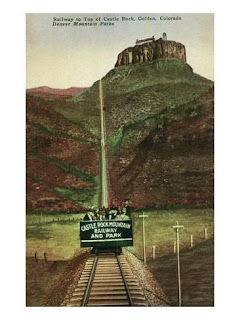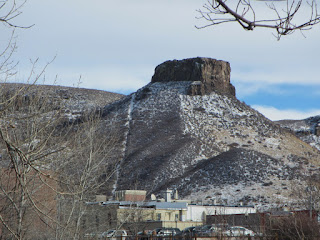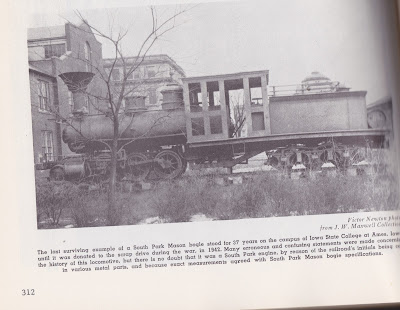As Mac Poor pointed out in his 1948 article, the C&S was often hampered by the problem of causing fires along their rights-of-way and thus eventually created what many now call a "Beartrap Spark Arrestor." This feature has become nearly synonymous with the Colorado & Southern narrow gauge being eventually applied to all their engines with the exception of No. 70 when it was converted to an oil burner.
In poking around for some info on this contraption I came across two curious sights on the internet. The first is a photo of unknown origin (at least to me. I forgot where I found it. Sorry!) showing what appears to be a logging railroad with a massive balloon stack version of a spark arrestor with not just one, but two tubes to drop the cinders along the right of way.
Curiously, it appears that the rail on the left side of the locomotive is not present!
Next, I found a photo of the D&RGW 346 wearing a Beartrap spark arrestor at the Colorado Railroad Museum in a 2015 photo. No. 346 did wear one of these during the time that the C&S borrowed it in the 1930s, but I didn't know that it sometimes wore it at the museum. Maybe those of you who are Colorado residents can let me know if this is a regular occurrence or not.
As I was writing this, I remembered that on a visit to the Durango and Silverton in the early 1990s, I saw one of their locomotives sporting one of these spark arrestors too. I have a video of this, but need to locate it to post.
Reflections on, insights about, research into, and visits to the remnants of the Colorado and Southern narrow gauge.
Sunday, April 23, 2017
Before and After Baker's Tank
A before and after photo I found of the Baker's tank on the Boreas pass route from Then and Now, Images of Colorado and the West. The original tank is on the left. The tank on the right was its replacement, moved here, if I am correct, from the west portal area of the Alpine Tunnel after the route was abandoned in 1910.
Old Railroad Route, These two photos show the same spot from
2 different era's and 2 vastly different modes of transportation. This is the
Bakers water tank on Boreas Pass. This road goes between Como in South Park on
highway 285 and Breckenridge. It crosses the continental divide and follows the
old rail bed of the Denver South Park and Pacific railroad. An old steam engine
is shown at the tank in 1887 and a nice family with their Pickup posed in the
same spot in 2014.
Sunday, April 16, 2017
Happy Easter: Resurrection on the C&S narrow gauge
Today many Christ-followers all around the globe are celebrating that God came to earth out of love in the person of Jesus with a task in mind. He came not on a war horse to conquer, but instead as a humble man who chose to die on a cross on what we now call Good Friday, and then to defeat the power of sin and death by being resurrected three days later.
The C&S narrow gauge has experienced a number of resurrections itself over the years since it's final breath in August of 1943. While The Resurrection holds much more significance, our collective enjoyment of even the resurrection of a railway points to something innate in our spirits that rejoices at something that once was lost but now has been found.
The first return to life was the short Central City Narrow Gauge Railroad that ran from 1968 to 1972. The second was the reincarnation of the Georgetown Loop, particularly as the high bridge was completed by 1984. The Central City route had a short revival from roughly 1987-1990 with a new operator. The next resurrection was in 1988 when a Leadville couple bought the Leadville to Climax route for $10 from the Burlington Northern and founded The Leadville, Colorado & Southern.
Today, however, another resurrection is in the works as The South Park Rail Society lays track (see photo) in
Como and is having a narrow gauge locomotive restored to run this year, the first locomotive to run there in nearly eight decades.
Below is an article from the March 2017 Rocky Mountain Railroad Club's Rail Report by Dave Schaaf and Chip:
The South Park Rail Society officially launched its funding
page to raise funds that will help with the repair and transportation of its
newly acquired locomotive for Como, Colorado. Depending on funding, the plan is
to have the locomotive moved and steamed up in Como during Park County’s 22nd
Annual Boreas Pass Railroad Day planned for August 19, 2017. If this event goes
well, they are considering having the locomotive steamed up again two weeks
later while the 37th National Narrow Gauge Convention is being held in nearby
Denver. The South Park Rail Society will
be releasing more details as they develop.
Their web site is www.southparkrail.com. [Their Facebook page mentioned on March 29th that "the goal is for this fall"].
Photo at left: kissing No. 4 goodbye as it leaves Silver Plume.
The South Park Rail Society locomotive is ex-Klondike Mines
Railway #4, a Baldwin Locomotive Works narrow gauge 2-6-2, built in 1912. This engine was unique among its roster in
having been manufactured for the Klondike Mines Railway (KMRy). Operating for a
mere two seasons on the KMRy, #4 and its tender were purchased by the White
Pass and Yukon Route in 1942 and was their WW II Skagway Yard switcher. The locomotive moved to Wisconsin in
1955. The locomotive was used on theme
park railways in the lower 48 states, most recently at the Dry Gulch Railroad
in Oklahoma, where it started a long restoration. In October 2015, KMRy #4 was
moved to the Georgetown Loop Railroad at Silver Plume, Colorado.
The locomotive left Silver Plume, Colorado, on February 21,
2017, and was trucked to Cheyenne,
Wyoming, arriving at Wasatch Railroad
Contractors, for service and repairs the next day.Photo at right: No. 4 arrives in Cheyenne.
So many "Thank You!"s go out to all of you in Colorado who are making this resurrection possible, especially from us too far away to lend a hand. We are so grateful!
All photos, except the Loop bridge, from The South Park Rail Society's Facebook page.
Labels:
C&S 71,
Central City,
Clear Creek,
Como,
Georgetown Loop,
Leadville
Saturday, April 15, 2017
Funicular Railways along the C&S and what remains
I have been enjoying Tom and Denise Klinger's series of books about the C&S "and then some" immensely. Recently I have been reading through their Clear Creek Memories edition and enjoyed learning about the several funicular railways that catered to tourists particularly from the C&S.

 One such railway was the Castle Rock Mountain (or sometimes named "Scenic") Railway that ascended to the top of South Table Mountain in Golden to the unique rock formation that gave the railway its name. The funicular operated from 1913 to 1918 (although online dates vary, the Klingers write that everything was sold in 1919). For many years this peak had a dance hall. Curiously, this dance hall was used by the KKK for a period of time in the 1920s. Eventually it burned down in 1927. A photo of the burning structure can be seen in the Klingers' book.
One such railway was the Castle Rock Mountain (or sometimes named "Scenic") Railway that ascended to the top of South Table Mountain in Golden to the unique rock formation that gave the railway its name. The funicular operated from 1913 to 1918 (although online dates vary, the Klingers write that everything was sold in 1919). For many years this peak had a dance hall. Curiously, this dance hall was used by the KKK for a period of time in the 1920s. Eventually it burned down in 1927. A photo of the burning structure can be seen in the Klingers' book.
So, what remains of this funicular? The abandoned roadbed is referred to as a scar and it is still recognizable according to sources I found online. One site states that the site of the present Golden water tank was the railway's terminal and that "You can still see the scar left by the track, but it gets fainter every year."
One site said the "rail ties" were slid down the mountain, presumably for scrap, around 1930. Another stated "It's rails were removed for use as scrap metal during WWI."
One very helpful site has a blog describing adventures in finding Colorado history. The author of the site (who also makes handmade soaps!) traced the remains and found that "From the top of Castle Rock, we could see the scar left by the funicular, which appears as a straight line highlighted by recent snow." In addition to remains of the dance hall at the top, they also found remains of other structures and unknown items along the roadbed which may or may not have been related to the railway.
Recent photos still show a very clear view of the former funicular's location, especially with a light dusting of snow.
References (in addition to the Klingers' book)
http://www.summitsoapstress.com/blog/2015/12/15/chasing-history-the-funicular-on-south-table-mountain
Old photos (except historical one are from the above blog post)
Old photos (except historical one are from the above blog post)
http://golden.com/wordpress/tag/lookout-mountain-funicular/ (Between the time that I first wrote this a few months ago and today, this site has disappeared)
Friday, April 7, 2017
Mac Poor article highlights: Shays on the South Park?
The following was an interesting excerpt:
"William Cairns and Jesse Frazier both write that the Colo. & Sou. was experimenting with number 25, a Shay engine, on Boreas Pass with a view of perhaps buying it. Evidently the Shay's performance did not justify its purchase as this engine was sold to a road in Utah."
Mac Poor article highlights: the C&S 'gizmo'
In doing some research for a new Bogies and the Loop article I came across an article by M.C. Poor published in the October 1948 Railway and Locomotive Historical Society Bulletin. It was entitled "The Locomotives of the South Park R. R."

The following was an interesting excerpt:
"Because of the great number of fires started along the right-of-way by the engines, the company developed a new 'gizmo' known as the cinder catcher. This contrivance resembled a big sausage hooked to the top of the stack and which hung down the side of the smoke box almost reaching the rails. It was so designed that the cinders, caught by a screen placed above the stack, were deflected and dropped to the ground through a curved pipe running down the side of the smoke box."

The following was an interesting excerpt:
"Because of the great number of fires started along the right-of-way by the engines, the company developed a new 'gizmo' known as the cinder catcher. This contrivance resembled a big sausage hooked to the top of the stack and which hung down the side of the smoke box almost reaching the rails. It was so designed that the cinders, caught by a screen placed above the stack, were deflected and dropped to the ground through a curved pipe running down the side of the smoke box."
Mac Poor article highlights: a Mason Bogie on display in Iowa?
In doing some research for a new Bogies and the Loop article I came across an article by M.C. Poor published in the October 1948 Railway and Locomotive Historical Society Bulletin. It was entitled "The Locomotives of the South Park R. R."
The following was an interesting excerpt:
"During the writer's search for locomotive material, an interesting incident concerning an old bogie type engine now standing on the grounds of the Iowa State College at Ames, Iowa, came to light. According to statements made in a college engineering publication of this school, this engine was built by Rogers Ketchum & Grosvenor of Peterson, New Jersey, in 1855 for The Mississippi & Missouri Railroad, and was the second railroad locomotive to enter the state of Iowa. This paper further states that later it was sold to the Denver & Rio Grande and still later to the Chicago, Burlington & Quincy, following which the engine was then retired and given to the College in 1904.

"However, a close inspection of this old engine by Mr. Guyon C. Whitely, a member of our Society and who lives in Ames, Iowa, discloses some interesting facts. The drive wheel diameters, wheel base, firebox dimensions, gauge and valve gear coincides exactly with the specifications of Mason engines built for the South Park company. The bade plate giving the builder's name and construction number is missing, but on the front of the right cylinder casting are the letters 'D.S.P.' Cast in a front wheel truck are the words 'Denver Wheel G.W. Co. Denver, Colo. Jan. 14, 1896 U.P.D.&G.' On both of the two rear wheels under the tender are the letters 'D.&S.P.' In view of this and other evidence, Mr. Chas. E. Fisher, Mr. Whitley, and the writer contend that this is an original Denver South Park & Pacific Mason Bogie. How the engine ever got to this final resting place is unknown."
The following was an interesting excerpt:
"During the writer's search for locomotive material, an interesting incident concerning an old bogie type engine now standing on the grounds of the Iowa State College at Ames, Iowa, came to light. According to statements made in a college engineering publication of this school, this engine was built by Rogers Ketchum & Grosvenor of Peterson, New Jersey, in 1855 for The Mississippi & Missouri Railroad, and was the second railroad locomotive to enter the state of Iowa. This paper further states that later it was sold to the Denver & Rio Grande and still later to the Chicago, Burlington & Quincy, following which the engine was then retired and given to the College in 1904.

"However, a close inspection of this old engine by Mr. Guyon C. Whitely, a member of our Society and who lives in Ames, Iowa, discloses some interesting facts. The drive wheel diameters, wheel base, firebox dimensions, gauge and valve gear coincides exactly with the specifications of Mason engines built for the South Park company. The bade plate giving the builder's name and construction number is missing, but on the front of the right cylinder casting are the letters 'D.S.P.' Cast in a front wheel truck are the words 'Denver Wheel G.W. Co. Denver, Colo. Jan. 14, 1896 U.P.D.&G.' On both of the two rear wheels under the tender are the letters 'D.&S.P.' In view of this and other evidence, Mr. Chas. E. Fisher, Mr. Whitley, and the writer contend that this is an original Denver South Park & Pacific Mason Bogie. How the engine ever got to this final resting place is unknown."
Mac Poor article highlights
 In doing some research for a new Bogies and the Loop article I came across an article by M.C. Poor published in the October 1948 Railway and Locomotive Historical Society Bulletin. It was entitled "The Locomotives of the South Park R. R."
In doing some research for a new Bogies and the Loop article I came across an article by M.C. Poor published in the October 1948 Railway and Locomotive Historical Society Bulletin. It was entitled "The Locomotives of the South Park R. R."This post and a the next few have some highlights that interested me.
In a discussion of the first locomotive on the South Park called "Fairplay," Poor writes,
"Joe Plunkett, veteran South Park runner now living in Grand Junction, Colorado, writes that, to the best of his recollection, no. 1 was later used to pump water at the roundhouse in Como but was taken up to Denver around 1884. No. 1 was scrapped in 1888. As far as the writer knows, no photograph of this engine exists."
Subscribe to:
Posts (Atom)







